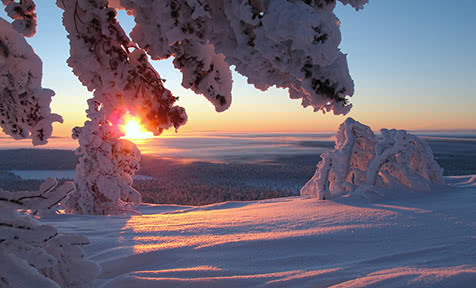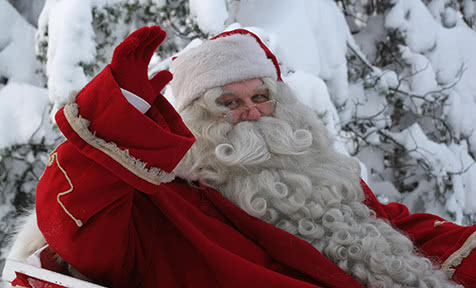Lapland weather & climate
Info & advice on Lapland’s climate and weather
Known for its winter days when the sun doesn’t rise and summer weeks when the sun doesn’t set… Lapland’s climate is truly fascinating and a world away from the weather we’re used to at home.
The region owes its crisp, wild landscape and snow sure ski seasons to cold, lengthy winters. With natural phenomena like the Northern Lights to boot, Mother Nature’s created a real work of art here.
with your own travel concierge. Don’t hesitate to drop us a line – we’ll
help plan your perfect Lapland Holiday.
020 7770 6888 ← online or call ↴
020 7770 6888
Lapland Weather
The first thing you’ll hear about Lapland’s climate is probably its long, cold winters. It’s the subarctic climate we have to thank for guaranteed white Christmases and superb ski seasons; this isn’t a place where you’ll enjoy a snow day if you’re lucky, this is somewhere that gets snow for a huge chunk of the year...
The locals describe Lapland as having a whopping 8 seasons and winter is by far the longest, lasting around 6 months. ‘Early winter’ is when the first snow appears, leading into ‘deep winter’ (or Christmas) with established snow cover and very few daylight hours. ‘Late winter’ sees frosty temperatures and lots of snow, leading into ‘spring’ which gets a lot more daylight but still has lovely ‘crusty’ snow.
That’s not to say Lapland is stuck in eternal winter like a real-life Narnia - while they’re few, Finnish Lapland’s summer months see some of Scandinavia’s best sunshine and there are weeks when the sun doesn’t drop below the horizon at all.
The ski season ends with the coming of ‘early summer’, when the ice starts to melt before ‘summer’, when the region becomes the land of the midnight sun. In ‘late summer’, things get more autumn-like with frosty nights setting in and when it comes to ‘autumn’, you get what the locals call ‘Ruska’, where the forests are beautifully colourful.
Snow in Lapland
Lapland’s sub zero temperatures and dry air add up to some pretty incredible snow conditions all season long...
With the ground being covered in snow for around 6 months a year, the ski resorts have much longer seasons than the ones in the Alps. The first snow can appear as early as the end of August on the highest peaks and proper coverage starts piling up from October onwards. Over a metre of snow cover is pretty standard throughout the season and the slopes are usually snow-sure from the end of November until early May. While the snow gods are very rarely stingy, most ski resorts have artificial snowmaking and with winter temps sticking below zero, snow cannons have the perfect conditions to get to work in.
Temperatures barely rise above freezing even at the end of the season, which means the slopes can avoid getting slushy and remain in good nick. When the Alps are usually praying for more snowfall as spring approaches, the snow just gets better here - the deepest snow is usually found around the beginning of April!
Average temperatures in Lapland
Temperatures tend to average around -16°C to -3°C between December and February but while this is colder than you’ll get in the French or Austrian ski resorts, you’re likely to have much better snow.
Despite the chilly climate, it tends to feel warmer than you expect here because of the clear, dry air. The resorts to a stellar job at making sure everyone stays warm, with campfire huts at the end of ski slopes, lots of cafes to warm up in and plenty of fun things to do indoors.
The mercury has been known to plummet to -30°C, so it’s good to pack lots of warm clothing, especially if you’re here in February (statistically the coldest month of the year). Buy or borrow a ski jacket with snow cuffs that can go under a good pair of gloves and pack lots of thermals to layer up underneath. We can usually arrange children’s snowsuit hire with bookings and these outfits do a fabulous job of keeping little ones snug and happy.
Give or take a couple of degrees, there isn’t a huge difference between the temperatures of the ski resorts. Saariselkä is the most northern resort which means it should be on the colder end of the scale, whilst in Iso Syote on the southern end, temperatures are likely to be a degree or two higher.
Lapland Daylight hours
Because most of the area is in the Arctic Circle, the daylight hours go from one extreme to another depending on what time of year you visit - in December, daylight is limited to 0-3 hours whereas in June, the sun’s known to be out for up to 24 hours a day.
Despite the sun not making much of an appearance in the middle of winter, this doesn’t mean the resorts are cast into utter darkness – the snow does a good job reflecting light and most slopes are floodlit so you can get a full ski day in. Rather than being a drawback, the lack of daylight is actually a huge bonus when it comes to upping your chances of seeing the legendary Northern Lights.
In March and April, the days are a lot longer and you can often ski for over 12 hours in natural light.
Snowfall and ski day averages for Lapland:
| Year | Snowfall Amount | Opening Date | Closing Date | Number of Skiing Days |
| 1978-79 | 128" | 11/23 | Mid-Apr. | 134 |
| 1979-80 | 124" | 11/19 | Early Apr. | 124 |
| 1980-81 | 104" | 12/17 | Records lost in fire | ------ |
| 1981-82 | 122" | 12/10 | 4/4 | 107 |
| 1982-83 | 118" | 12/3 | 3/29 | 110 |
| 1983-84 | 130" | 12/8 | 4/1 | 112 |
| 1984-85 | 113" | 12/8 | 4/6 | 118 |
| 1985-86 | 125" | 11/30 | 3/31 | 120 |
| 1986-87 | 121" | 11/22 | 3/25 | 124 |
| 1987-88 | 106" | 12/16 | 4/2 | 108 |
| 1988-89 | 86" | 12/17 | 3/26 | 100 |
| 1989-90 | 125" | 11/22 | 4/15 | 132 |
| 1990-91 | 110" | 12/8 | 4/6 | 117 |
| 1991-92 | 100" | 12/6 | 4/4 | 108 |
| 1992-93 | 187" | 12/12 | 4/18 | 122 |
| 1993-94 | 185" | 12/21 | 4/17 | 113 |
| 1994-95 | 94" | 11/23 | 3/26 | 117 |
| 1995-96 | 162" | 11/18 | 3/31 | 127 |
| 1996-97 | 189" | 11/30 | 4/6 | 123 |
| 1997-98 | 137" | 11/15 | 3/29 | 130 |
| 1998-99 | 140" | 12/20 | 3/29 | 100 |
| 1999-00 | 124" | 12/18 | 3/26 | 95 |
| 2000-01 | 163" | 12/13 | 4/1 | 109 |
| 2001-02 | 115" | 12/9 | 4/7 | 110 |
| 2002-03 | 180" | 11/19 | 4/13 | 140 |
| 2003-04 | 131" | 12/7 | 4/5 | 121 |
| 2004-05 | 115" | 12/8 | 4/1 | 110 |
| 2005-06 | 101" | 11/25 | 3/26 | 121 |
| 2006-07 | 146" | 12/26 | 4/22 | 103 |
| 2007-08 | 145" | 12/2 | 4/14 | 133 |
| 2008-09 | 145" | 11/26 | 4/5 | 125 |
| 2009-10 | 80" | 12/9 | 3/21 | 103 |
| 2010-11 | 153" |
"12/17 Woods Lake 1/7 full system " |
4/10 | 91-102 |
| 2011-12 | 62" |
"12/28 Woods Lake 1/14 full system " |
3/17 | 65-77 |
| 2012-13 | 106" | 12/23 | 4/5 | 107 |
| 2013-14 | 136" | 11/30 | 4/6 | 118 |
Polar night and Midnight Sun
In the middle of winter, Lapland has Polar Nights (“kaamos” in Finnish), when the sun doesn’t rise above the horizon at all. It’s an absolutely magical time to visit and makes for a once in a lifetime experience - rather than being pitch black, you get a few hours of enchanting twilight, when the moonlight and northern lights are reflected off the snow.
The opposite happens in the summer where there’s a polar phenomenon called the Midnight Sun. Lapland is renowned for this and its ‘Nightless Nights’ take from in late May till July where the sun never drops below the horizon.
| Month | Average daylight hours |
| January | 4.5 |
| February | 6.5 |
| March | 10.5 |
| April | 14.5 |
| May | 18.5 |
| June | 22.5 |
| July | 18.5 |
| August | 14.5 |
| September | 10.5 |
| October | 6.5 |
| November | 4.5 |
| December | 1.5 |
Average temperatures and daylight hours and snow depth for Lapland:
| Month | Temperature Averages - High/Low (Typically showing Day/Night) | Overall Average Temperature | Length of Day (sunrise to sunset) | Time of Sunrise/Sunset | Average Snow Depth |
| December | - 7°C /- 16 °C | -12 °C | 0.75 hours | 11:46/12:32 | 30 cm |
| January | - 8°C /- 17 °C | -14 °C | 3.75 hours | 10:30/14:18 | 50 cm |
| February | - 8°C /- 17 °C | -13 °C | 6 hours | 08:29/16:28 | 90 cm |
| March | - 3°C /- 13 °C | -8 °C | 11.75 hours | 06:31/18:15 | 90 cm |
| April | + 3 °C /- 6 °C | -2 °C | 15.75 hours | 06:26/20:12 | 80 cm |
Images © Visit Finland
Lapland weather FAQ:
Extremely cold! During the winter season, the temperature can range from 0°C to -30°C. However, it does not always feel as cold as you would imagine due to the winters being dry and not very windy. Appropriate clothing can be hired in the resort, so do not worry about having to splash out arranging appropriate thermal gear before going on holiday.
The snow starts falling in Lapland as early as October, and it snows on and off through until April. It can get extremely cold with temperatures falling to as low as -30°C. The daylight hours range from 2-6 hours a day during the winter months.
The average temperature in November is -6°C. The snowfall average is usually around 7cm, with a 54% chance of a snow day. The average daylight hours are 6.2 hours per day, cloud dependant.
The average temperature in December is -9°C. The snowfall average is usually around 7.5cm, with a 72% chance of a snow day. The average daylight hours are 2.1 hours per day, cloud dependant.
The average temperature in January is -13°C. The snowfall average is usually around 9cm, with 81% chance of a snow day. The average daylight hours are 2.3 hours per day, cloud dependant.
Yes - the snow falls in Lapland from as early as October and snows through until April time. On average you are looking at a maximum snow depth of 1.2metres by March before heading into the warmer season.































